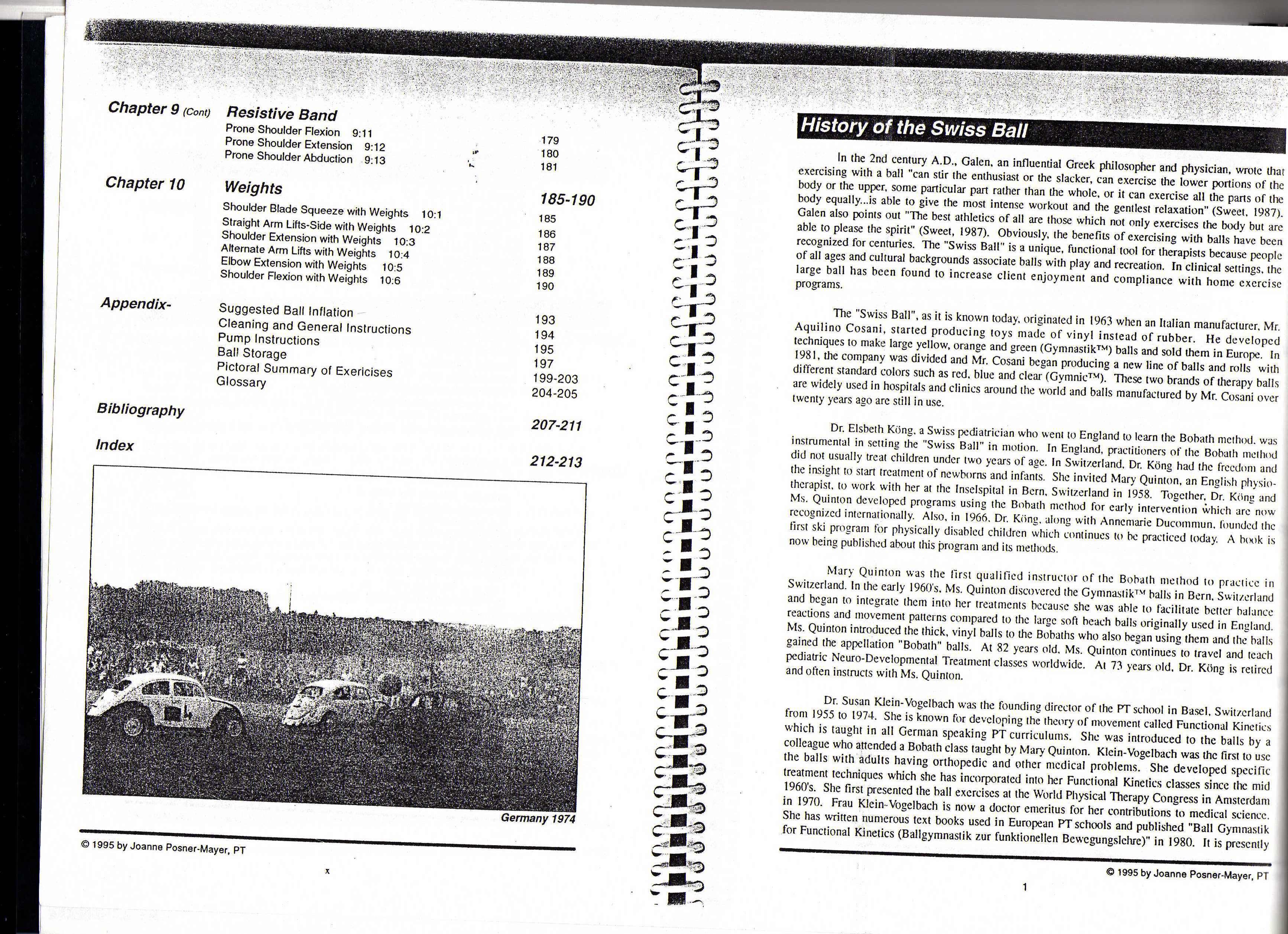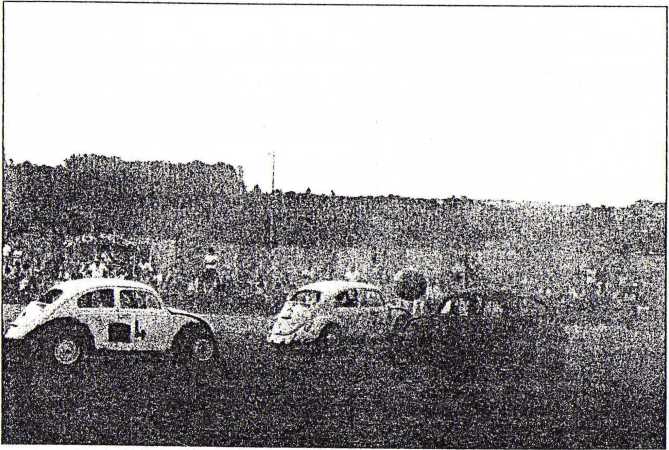img014


|
Chapter 9 <cont) |
Resistive Band Prone Shoulder Flexion 9:11 Prone Shoulder Extension 9:12 „ Prone Shoulder Abduclion 9:13 k |
179 180 181 |
|
Chapter 10 |
Weights Shoulder Blade Squeeze with Weights 10:1 Straight Arm Lifts-Side wilh Weights 10:2 Shoulder Extension with Weights 10:3 Alternate Arm Lifts with Weights 10:4 Elbow Extension with Weights 10:5 Shoulder Flexion with Weights 10:6 |
185-190 185 186 187 188 189 190 |
|
Appendix- |
Suggested Bali Inflation Cteaning and General Instructions Pump Instructions Bali Storage Pictoral Summary of Exericises Glossary |
193 194 195 197 199-203 204-205 |
|
Bibliography |
207-211 | |
|
lndex |
212-213 |

Germany 1974
© 1995 by Joannę Posner-Mayer, PT
History of the Swiss Bali

In the 2nd century A.D., Galen, an influential Greek philosopher and physician, wrotc ihat exercising with a bali "can slir the enthusiast or the slacker, can exercise the lower portions of the body or the upper, sonie particular part rather than the whole, or it can exercise all the parts of the body equally...is ahle to give the most intense workout and the gentlest rclaxation” (Sweet. 1987). Galen also points out "The best athletics of all are those which not only exercises the body but are ablc to please the spirit" (Sweet, 1987). Obviously, the benefits of exercising with balls havc bccn recognized for centuries. The "Swiss Bali" is a unique, functional tool for therapists because pcoplc of all ages and cultural backgrounds associate balls with play and recreation. In clinica! settings, the iarge bali has bcen found to increase Client enjoyment and compliance with home cxcrcise programs.
The "Swiss Bali", as it is known today, originated in 1963 when an Italian manufacturer, Mr. Aquilino Cosani, started producing toys madę of viny! instead of rubber. He devc!opcd techniques to make large yellow, orange and green (Gymnastik™) balls and sold them in Europę. In 1981, the company was divided and Mr. Cosani began producing a new linę of balls and rolls with different standard eolors such as red. blue and elear (Gymnic™). These two brands of therapy balls are widely used in hospitals and clinics around the world and balls manufacturcd by Mr. Cosani over twenty years ago are still in use.
Dr. Elsbeth Kiing. a Swiss pediatrician who went to England to leam the Bobath method. was instrumentu! in setting the "Swiss Bali" in motion. In England, practitioners of the Bobath method did not usually treat children under two years of age. In Switzerland. Dr. Kong had the freedom and the insight to start treatment of newborns and infants. She inviled Mary Quinlon, an English physio-therapist, to work with her at the Inselspital in Bern. Switzerland in 1958. Together, Dr. Kong and Ms. Quinton developed programs using the Bobath method for early intervention which are now recognized internationally. Also, in 1966. Dr. Kong. along with Annemarie Ducommun, founded the tirst ski program for physically disabled children which continues to be practiced today. A htxik is now being published about this program and its methods.
Mary Quinton was the ftrst qualified instructor of the Bobath method to praclicc in Switzerland. In the early 1960's. Ms. Quinton discovered the Gymnastik™ balls in Bern. Switzerland and began to integrate them into her treatments because she was ahle to facilitatc better balance reactions and movement patterns comparcd to the large soft beach balls originally used in England. Ms. Quinton introduced the thick, vinyl balls to the Bobaths who also began using them and the balls gained the appellation "Bobath" balls. At 82 years old. Ms. Quinton continues to travel and tcach pediatrie Ncuro-Deveiopmenta! Treatment classes worldwide. Al 73 years old. Dr. Kiing is retired and often instructs with Ms. Quinton.
Dr. Susan Klein-Vogelbach was the founding directorof the PT school in Basel. Switzerland from 1955 to 1974. She is known for devcloping the theory of movemcnt called Functional Kinelics which is taught in all German speaking PT curriculums. She was introduced to the balls by a colleague who attended a Bobath class taught by Mary Quinton. Ktcin-Vogelbach was the first to use the balls with adults having orthopedic and other mcdical problems. She developed specific treatment techniąues which she has incorporatcd into her Functional Kinetics classes sińce the mid 1960’s. She first presented the bali exercises at the World Physical Therapy Congress in Amsterdam in 1970. Frau Klein-Vogelbach is now a doctor emeritus for her contributions to mcdical science. She has written numerous text books used in European PT schools and published "Bali Gymnastik for Functional Kinetics (Ballgymnastik zur funktionellen Bewcgungslchre)" in 1980. It is prescntly
© 1995 by Joannę Posner-Mayer, PT
1
Wyszukiwarka
Podobne podstrony:
img102 Datę. Name.Resistive Band Prone Shoulder Extension 9.12 Starting Position: Lie prone over bal
39045 img095 Shoulder Fiexion 9:6 Chapter 9 Resistive Band rnĘmmĘKm Shoulder
img069 Chapter 5V «y p;- . ,. ■■-;:■ 9 m ,
img098 Datę_ Name.Resistive Band Shoulder and Elbow Extension 9:4 Starting Position: Sit on bali in
img101 Dnte___ Name.Resistive Band Knee Flexion/Hip Extension 9.10 Starting Position: Sit on bali in
więcej podobnych podstron